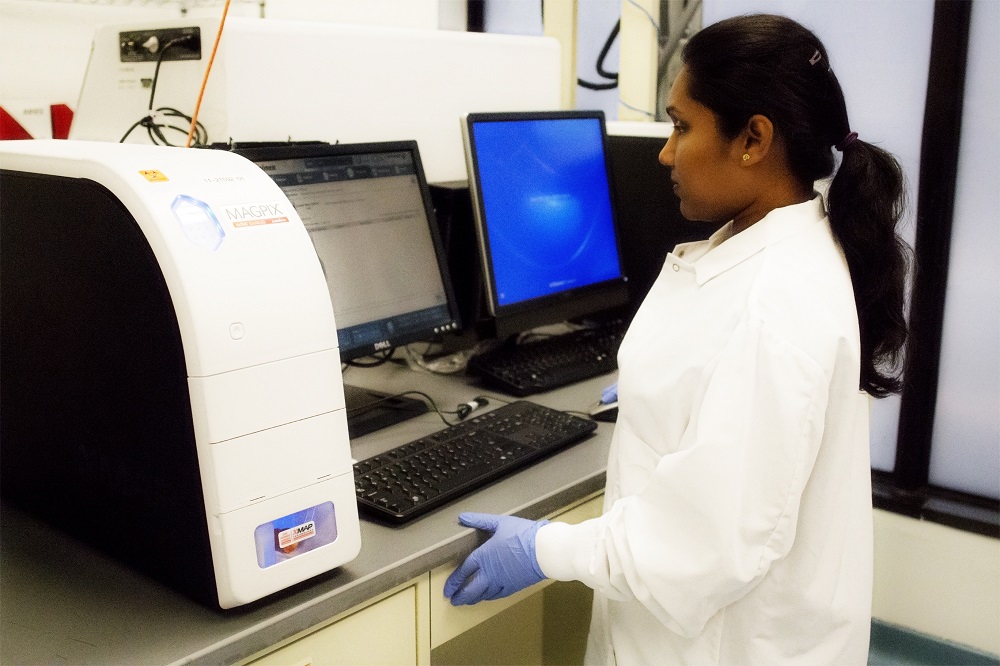
The Luminex MAGPIX multiplex instrument performs up to 50 different tests in a single reaction volume.
Throughout the preclinical and clinical stages of drug development, there is a growing need for sensitive immunoassays to assess clinically relevant markers of therapeutic response to a drug or immunotherapy, as well as markers of toxicity. The need for so much testing has put pressure on drug discovery scientists to rein in costs and optimize sample usage by designing multiplex assays to cover several analytes simultaneously. When this is done successfully, the reagent savings alone are enough to make a material difference. Factor in the time saved by running the equivalent of 20 or more different assays in a single immunoassay workflow, and it’s obvious why pharma and biotech companies are so interested in this approach.
Choosing to multiplex assays also offers benefits beyond cost. In drug discovery pipelines, sample availability is well known as a rate-limiting factor. Patient samples, and even samples from model mice, can be scarce. Assessing multiple analytes in a single assay allows scientists to be judicious with precious materials while generating much more useful information, alleviating the need to prioritize assays based on the volume of precious samples and allowing for future studies using those same samples.
While multiplexing is undeniably more cost-effective than running a series of single-analyte immunoassays, it introduces several technical challenges that make assay design more complicated. For example, individual assays were designed to be analyte-specific — meaning that every component, from buffer to antibody pairs and more, could be custom-tailored for that specific analyte. Assays incorporating several analytes don’t have this luxury. Multiplexing calls for carefully chosen compromises that allow analytes to play well together while still producing accurate, meaningful results.
Technical considerations
While there are several important factors to take into account when designing a high-quality multiplex immunoassay, these are some of the critical considerations:
Selecting the right antibody pairs. As with many immunoassays, a sandwich ELISA-type format is often employed, where the assay consists of a pair of antibodies, one that is used to capture a marker of interest and a second detection antibody to measure the captured material. Screening antibody pairs for optimal performance, such as specificity, linearity, and sensitivity is a time-intensive process that requires access to a library of antibodies and a great deal of research to confirm that the antibodies under consideration can produce consistent results. Validation protocols ensure that antibodies are producing appropriate results. For example, an assay that was reporting sky-high IL-5 values from a healthy individual but not from stimulated peripheral blood mononuclear cells (PBMCs) would be a red flag that the quality of the assay is not acceptable.
Finding the best buffer. A significant challenge in designing effective multiplex assays is identifying a buffer system that performs properly for all of the analytes of interest within a panel. Since it is not possible to customize the buffer to any individual analyte, optimizing buffers for peak performance, such as linearity or recovery, and managing matrix effects are key steps to ensuring sensitivity, precision, and accuracy of the resulting immunoassay. In the best scenario, an assay diluent works well with a broad range of analytes, allowing scientists to multiplex anywhere from a few to several dozen analytes within a single test.
Assay validation. To ensure a robust assay, biological validation of the antibody pairs by western blot allows for confirmation of the assay specificity by verifying that the antibodies are detecting a protein of the correct molecular weight. Testing recovery and sample linearity ensures the precision and accuracy of the sample values being generated. Evaluation of inter- and intra-assay precision ensures the reproducibility of the sample values being reported between users and within a single assay, a key measure of the reliability of the assay.
Moving forward
Immunoassay developers strive for many performance goals—particularly specificity, sensitivity, precision, accuracy, and reproducibility. While developing a multiplex assay presents technical development challenges compared to single analyte, plate-based ELISA, the ability to generate high-quality data while dramatically reducing time and costs needed for testing is a boon for investigators. From narrowing down drug candidates in preclinical studies to evaluating therapeutic responses during a clinical trial, these assays are essential for the success of drug discovery and development efforts. In most cases, the development of multiplex immunoassays is complex enough that researchers anywhere from academia and biotech to large pharma prefer to work with external experts who have the experience and access to vast libraries of antibodies to develop their assays. But regardless of whether the work is outsourced or conducted in-house, paying attention to the technical factors explored here will significantly improve the chances for developing high-quality and effective multiplex assays.
Andrew Hudacek is the Custom Luminex Assay Supervisor at Bio-Techne.
Filed Under: Drug Discovery




